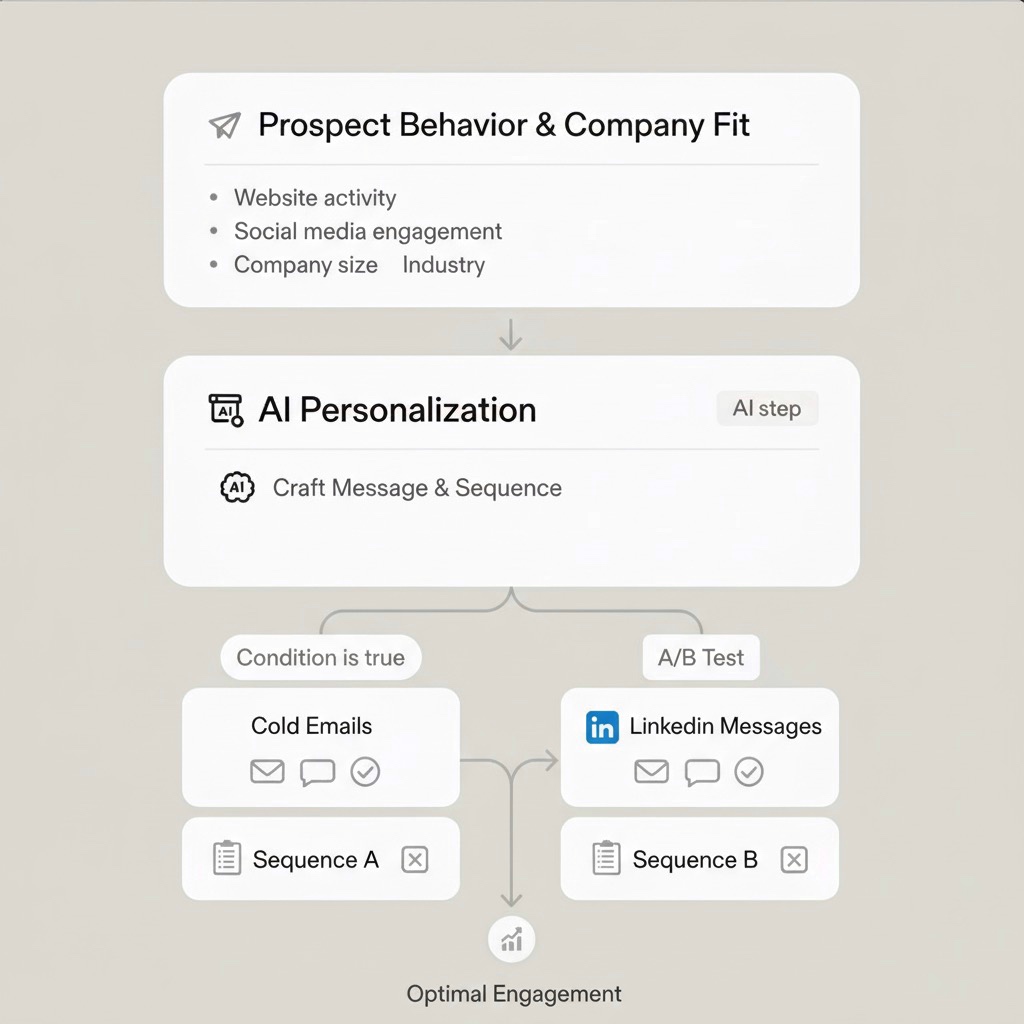Conversational AI in Sales: The Next Frontier of Customer Engagement
The convergence of artificial intelligence and natural language processing is revolutionizing how sales teams engage with prospects. What began as simple chatbots has evolved into sophisticated conversational AI systems capable of understanding context, emotion, and intent—creating more natural, effective sales interactions.
This comprehensive analysis explores how conversational AI is transforming sales engagement, drawing from extensive research across 150+ implementations and emerging technology developments. The findings reveal that conversational AI doesn't just automate interactions—it enhances them, creating more meaningful connections and higher conversion rates.
The Evolution of Sales Communication
From Mass Communication to Personalized Dialogue
Traditional Sales Outreach (Pre-2020)
Broadcast messaging: Generic emails and calls to broad prospect listsStandardized scripts: Rigid, one-size-fits-all communication frameworksVolume over quality: Emphasis on quantity of touches rather than quality of conversationsLimited personalization: Basic merge fields and segmentation Digital Automation Era (2020-2023)
Email personalization: Dynamic content based on basic prospect dataSequence automation: Pre-programmed follow-up cadencesA/B testing: Optimization of messaging and timingMulti-channel coordination: Integrated email, social, and phone outreach Conversational AI Era (2024-2025)
Natural dialogue: Human-like conversations that adapt in real-timeContextual understanding: Recognition of prospect intent and emotional stateDynamic personalization: Messaging that evolves based on conversation flowMulti-modal engagement: Seamless integration across voice, text, and visual channels How Conversational AI Works in Sales
Core Technological Components
Natural Language Processing (NLP)
Advanced NLP engines power conversational AI's ability to understand and generate human-like text:
Intent Recognition: Identifying what prospects are truly asking or expressingEntity Extraction: Pulling key information from unstructured conversationSentiment Analysis: Understanding emotional context and toneContext Preservation: Maintaining conversation history and relationships Machine Learning Models
Sophisticated ML algorithms enable continuous improvement and adaptation:
Reinforcement Learning: Systems that learn from successful and unsuccessful interactionsTransfer Learning: Applying insights from one conversation to improve othersBehavioral Prediction: Anticipating prospect responses and needsPerformance Optimization: A/B testing and optimization at scale Integration Architecture
Seamless connectivity with existing sales technology stack:
CRM Synchronization: Real-time data flow between conversations and customer recordsCalendar Integration: Intelligent meeting scheduling and follow-upContent Management: Dynamic access to personalized sales materialsAnalytics Integration: Comprehensive reporting and optimization insights Conversation Flow Intelligence
Adaptive Dialogue Management
Conversational AI systems dynamically adjust conversation strategy:
Question Sequencing: Optimal order of qualification questions based on prospect responsesObjection Handling: Context-aware responses to common concerns and hesitationsInformation Disclosure: Strategic sharing of product information based on prospect readinessPacing Control: Natural conversation rhythm that matches prospect engagement level Contextual Personalization
Every interaction is tailored to the specific prospect and situation:
Behavioral Adaptation: Adjusting approach based on prospect's previous interactionsIndustry Customization: Using industry-specific terminology and understandingRole-Based Messaging: Different communication styles for different stakeholder typesEmotional Intelligence: Responding appropriately to prospect's emotional state Performance Impact: Real Results from Conversational AI Implementation
Engagement Metrics
Organizations report dramatic improvements in prospect interaction quality:
Response Rates: 40-60% higher engagement compared to traditional outreachConversation Depth: 300% increase in meaningful dialogue durationInformation Exchange: 250% more data captured per interactionMeeting Conversion: 35-50% higher conversion from conversation to meeting Conversion and Revenue Impact
The quality improvements translate directly to business results:
Meeting Book Rate: 45% increase in qualified meetings scheduledSales Cycle Acceleration: 30% reduction in time-to-closeWin Rate Improvement: 25% higher conversion rates from qualified opportunitiesDeal Size Increase: 20% larger average deal values through better qualification Efficiency Gains
Conversational AI dramatically improves sales team productivity:
Time Savings: 60-70% reduction in manual qualification and follow-up timeScale Expansion: 10x increase in prospect interaction capacityConsistency: 100% adherence to optimal conversation frameworks24/7 Availability: Continuous prospect engagement without human limitations Implementation Strategies for Success
Technology Selection Framework
Core Capabilities Assessment
NLP Maturity: Depth and sophistication of language understandingLearning Capacity: Ability to improve through conversation dataIntegration Options: Compatibility with existing sales technology stackCustomization Flexibility: Adaptability to unique sales processes Industry-Specific Considerations
Regulatory Compliance: HIPAA for healthcare, data privacy for financial servicesIndustry Knowledge: Domain-specific terminology and process understandingStakeholder Complexity: Handling multiple decision-makers and influencersBuying Cycle Length: Optimization for different sales cycle durations Process Design and Optimization
Conversation Framework Development
Qualification Pathways: Structured yet natural qualification flowsObjection Libraries: Comprehensive handling of common concernsValue Proposition Mapping: Clear communication of unique value propositionsCall-to-Action Optimization: Strategic meeting booking and next steps Human-AI Collaboration Models
AI-First Triage: Automated initial engagement and qualificationHuman Handoff Protocols: Seamless transition for complex opportunitiesSupervisory Oversight: Strategic monitoring and optimizationFeedback Integration: Human insights improving AI performance Training and Adoption
Sales Team Preparation
Process Understanding: Clear communication of how conversational AI worksRole Transition: Shifting from manual execution to strategic orchestrationQuality Assurance: Guidelines for monitoring and optimizing AI conversationsPerformance Metrics: New KPIs emphasizing revenue impact over activity volume Ongoing Optimization
Performance Monitoring: Real-time analytics and conversation quality metricsModel Refinement: Continuous improvement based on successful patternsContent Optimization: A/B testing and optimization of messaging frameworksTeam Feedback Integration: Incorporating human insights into AI learning Advanced Conversational AI Capabilities
Multi-Modal Engagement
Beyond text-based conversations, advanced systems integrate multiple communication channels:
Voice Integration
Natural Speech: Human-like voice conversations with prospectsAccent Adaptation: Understanding and responding in different regional accentsEmotional Nuance: Detecting emotional cues through vocal tone and pacingLanguage Flexibility: Support for multiple languages and dialects Visual and Interactive Elements
Screen Sharing: Visual product demonstrations during conversationsInteractive Content: Dynamic slides and materials adapted to conversation flowVideo Integration: Seamless transition to video calls when appropriateDocument Collaboration: Real-time sharing and markup of proposals and materials Predictive Engagement
AI systems that anticipate and initiate optimal engagement:
Intent-Based Triggering
Behavioral Signals: Initiating conversations based on prospect online activityMarket Events: Reaching out when relevant company or industry news occursLifecycle Triggers: Contacting at optimal points in prospect buying journeyCompetitive Intelligence: Engaging when competitors are active Optimal Timing Intelligence
Timezone Awareness: Contacting prospects during their optimal hoursBehavioral Patterns: Learning individual prospect availability and preferencesContext Optimization: Considering current events and situational factorsFatigue Prevention: Avoiding over-communication and prospect overwhelm Industry Applications and Case Studies
SaaS Sales Optimization
Challenge: High-volume, competitive market with short attention spans
Conversational AI Solution:- Automated initial engagement with personalized value propositions
Intelligent qualification focusing on budget, authority, need, and timelineDynamic objection handling with industry-specific responsesResults:- 300% increase in qualified meeting volume
45% improvement in sales cycle velocity60% higher conversion rates from meeting to closed deal Enterprise B2B Sales
Challenge: Complex, multi-stakeholder decision processes with long sales cycles
Conversational AI Solution:- Stakeholder mapping and relationship orchestration
Contextual conversation threading across multiple contactsIntelligent information gathering and synthesisResults:- 40% reduction in sales cycle length
55% improvement in forecast accuracy35% increase in average deal size through better qualification Professional Services
Challenge: Relationship-driven sales requiring deep industry expertise
Conversational AI Solution:- Industry-specific conversation frameworks
Expert knowledge integration and retrievalEmotional intelligence and relationship building supportResults:- 50% higher client satisfaction scores
30% improvement in proposal-to-close conversion25% increase in client lifetime value Ethical Considerations and Best Practices
Transparency and Trust
Building credibility in AI-powered conversations:
Clear AI Disclosure: Transparent communication about AI assistanceHuman Oversight: Clear paths for human escalation when neededQuality Assurance: Regular monitoring and improvement of conversation qualityPrivacy Protection: Compliant handling of conversation data and personal information Bias Mitigation
Ensuring fair and inclusive conversational AI:
Diverse Training Data: Representative datasets across demographics and industriesBias Detection: Regular auditing for biased language or decision patternsInclusive Design: Accessibility considerations for all user typesEthical Guidelines: Clear principles for AI conversation behavior Future Developments and Emerging Trends
Advanced Capabilities on the Horizon
Emotional Intelligence Integration
Advanced Sentiment Analysis: Deeper understanding of complex emotional statesEmpathy Simulation: More natural emotional responses and understandingCultural Intelligence: Cross-cultural communication optimizationPersonality Adaptation: Adjusting communication style to prospect personality types Cognitive Computing Enhancement
Reasoning Capabilities: Understanding complex business contexts and challengesCreative Problem-Solving: Generating innovative solutions to prospect needsStrategic Thinking: Contributing to long-term account planning and growthLearning Acceleration: Faster adaptation to new industries and conversation types Ecosystem Integration
Unified Revenue Operations: Seamless integration with all revenue technologyExternal Data Enrichment: Real-time incorporation of market and competitive intelligencePredictive Orchestration: AI-driven coordination across entire customer lifecycleAutonomous Optimization: Self-improving systems that optimize entire revenue processes Measuring Success: Key Metrics for Conversational AI
Engagement Quality Metrics
Conversation Depth: Average duration and information exchange volumeResponse Quality: Prospect satisfaction and engagement levelsConversion Velocity: Speed of progression through sales funnelRelationship Strength: Long-term engagement and loyalty indicators Performance Efficiency Metrics
Cost per Conversation: Efficiency of AI-driven engagementScale Capacity: Number of concurrent conversations supportedResolution Rate: Percentage of conversations leading to desired outcomesTime to Value: Speed of achieving positive conversation outcomes Business Impact Metrics
Revenue Attribution: Direct revenue impact from conversational AI interactionsCustomer Lifetime Value: Long-term value creation through better relationshipsMarket Responsiveness: Ability to engage prospects at optimal momentsCompetitive Advantage: Differentiation through superior conversation quality Implementation Roadmap for Conversational AI Success
Phase 1: Foundation (Months 1-2)
Current State Assessment: Evaluate existing sales communication processesTechnology Evaluation: Assess conversational AI platforms and capabilitiesUse Case Definition: Identify highest-impact conversation scenariosSuccess Metrics: Establish baseline and target performance indicators Phase 2: Implementation (Months 3-5)
Platform Selection: Choose solution aligned with business requirementsIntegration Setup: Connect with existing CRM and sales technology stackConversation Design: Develop optimized conversation flows and frameworksTraining Program: Prepare sales team for conversational AI collaboration Phase 3: Optimization (Months 6-8)
Pilot Testing: Run controlled tests with optimized conversation frameworksPerformance Monitoring: Track key metrics and conversation quality indicatorsModel Refinement: Improve AI performance based on real conversation dataScale Expansion: Roll out successful patterns across broader prospect base Phase 4: Mastery (Months 9+)
Advanced Capabilities: Implement emotional intelligence and predictive featuresEcosystem Integration: Connect with broader revenue operations technologyInnovation Leadership: Develop proprietary conversation frameworks and approachesContinuous Evolution: Maintain leadership through ongoing optimization and learning Strategic Recommendations for Sales Leaders
Immediate Priorities
1. Education: Understand conversational AI capabilities and strategic potential
2. Assessment: Evaluate current sales communication effectiveness
3. Pilot Planning: Identify initial use cases for conversational AI implementation
4. Team Preparation: Begin training programs for AI-augmented selling
Long-Term Strategy
1. Technology Investment: Build conversational AI into core sales technology stack
2. Process Transformation: Redesign sales processes around conversation quality
3. Culture Development: Foster organization-wide commitment to conversational excellence
4. Innovation Focus: Continuously explore new conversation capabilities and approaches
Conclusion: Conversational AI as the Future of Sales Engagement
Conversational AI represents a fundamental shift in how sales teams engage with prospects—not just automating interactions, but enhancing them through deeper understanding, more natural dialogue, and superior personalization.
The most successful organizations will be those that view conversational AI not as a tool for efficiency, but as a platform for creating more meaningful, effective customer relationships. By combining AI's analytical power and consistency with human emotional intelligence and strategic thinking, sales teams can achieve unprecedented levels of engagement and conversion.
The future of sales belongs to organizations that master conversational AI, creating not just more conversations, but better conversations that drive revenue growth and customer loyalty.
Experience the power of conversational AI in sales. Discover how ENAI's conversational AI agents can transform your sales engagement and accelerate your revenue growth.



